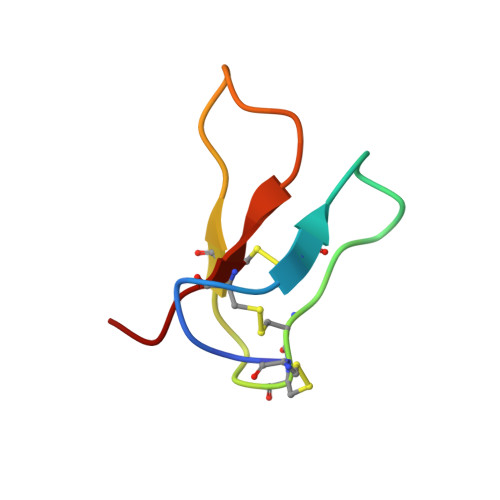Solution structure of Alo-3: a new knottin-type antifungal peptide from the insect Acrocinus longimanus.
Barbault, F., Landon, C., Guenneugues, M., Meyer, J.P., Schott, V., Dimarcq, J.L., Vovelle, F.(2003) Biochemistry 42: 14434-14442
- PubMed: 14661954
- DOI: https://doi.org/10.1021/bi035400o
- Primary Citation of Related Structures:
1Q3J - PubMed Abstract:
Insect peptides are key elements of the innate immunity against bacteria and fungi. These molecules offer remarkable properties: high efficacy, a low probability of resistance, limited toxicity, and immunogenicity. In this context, we are investigating several classes of peptides, and we have been successful in identifying biologically important classes of peptides and small molecules that will provide a stream of drug candidates for treating severe, life-threatening, hospital-acquired infections and other pathologies of high medical need. Recently, we have isolated a new class of antifungal peptides from the coleopteran Acrocinus longimanus. Three homologous peptides, Alo-1, Alo-2, and Alo-3, with sequence identity above 80% and active against the Candida glabrata yeast strain were identified. Alo-3 displayed the highest activity against Candida glabrata and was thus chosen for structure determination using NMR spectroscopy and molecular modeling. Alo-3 contains six cysteine residues forming three disulfide bridges. The pairing of the cysteines was assessed using ambiguous disulfide restraints within the ARIA software, allowing us to establish that Alo-3 belongs to the inhibitor cystine-knot family. It exhibits all the structural features characteristic of the knottin fold, namely, a triple-stranded antiparallel beta-sheet with a long flexible loop connecting the first strand to the second strand and a series of turns. To our knowledge, Alo-3 is the first peptide from insects with antimicrobial activity adopting the knottin fold. Alo-3 shows a level of activity significantly higher against C. glabrata than Alo-1 or Alo-2. It has no negatively charged residues and displays on its surface a cationic pole that may account for its antifungal activity. This finding is validated by the comparison of the structure of Alo-3 with the structure of other structurally related peptides from other sources also showing antifungal activity.
Organizational Affiliation:
Centre de Biophysique Moléculaire, CNRS UPR 4301, rue Charles Sadron, 45071 Orléans Cedex 2, France.














